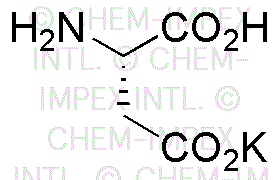L-Aspartic acid potassium salt is widely utilized in research focused on:
- Nutrition Supplements: This compound is often included in dietary supplements aimed at enhancing athletic performance and recovery due to its role in energy production and amino acid synthesis.
- Pharmaceuticals: It serves as an excipient in drug formulations, improving solubility and stability, which is crucial for effective delivery of active pharmaceutical ingredients.
- Agriculture: Used as a fertilizer additive, it promotes plant growth by enhancing nutrient absorption and improving stress resistance, making it valuable for crop yield optimization.
- Food Industry: It acts as a flavor enhancer and is utilized in food products to improve taste profiles, appealing to consumers looking for healthier food options.
- Biotechnology: In research labs, it is employed in cell culture media, supporting the growth of various cell types, which is essential for studies in genetics and drug development.
General Information
Properties
Safety and Regulations
Applications
L-Aspartic acid potassium salt is widely utilized in research focused on:
- Nutrition Supplements: This compound is often included in dietary supplements aimed at enhancing athletic performance and recovery due to its role in energy production and amino acid synthesis.
- Pharmaceuticals: It serves as an excipient in drug formulations, improving solubility and stability, which is crucial for effective delivery of active pharmaceutical ingredients.
- Agriculture: Used as a fertilizer additive, it promotes plant growth by enhancing nutrient absorption and improving stress resistance, making it valuable for crop yield optimization.
- Food Industry: It acts as a flavor enhancer and is utilized in food products to improve taste profiles, appealing to consumers looking for healthier food options.
- Biotechnology: In research labs, it is employed in cell culture media, supporting the growth of various cell types, which is essential for studies in genetics and drug development.
Documents
Safety Data Sheets (SDS)
The SDS provides comprehensive safety information on handling, storage, and disposal of the product.
Product Specification (PS)
The PS provides a comprehensive breakdown of the product’s properties, including chemical composition, physical state, purity, and storage requirements. It also details acceptable quality ranges and the product's intended applications.
Certificates of Analysis (COA)
Search for Certificates of Analysis (COA) by entering the products Lot Number. Lot and Batch Numbers can be found on a product’s label following the words ‘Lot’ or ‘Batch’.
*Catalog Number
*Lot Number
Certificates Of Origin (COO)
This COO confirms the country where the product was manufactured, and also details the materials and components used in it and whether it is derived from natural, synthetic, or other specific sources. This certificate may be required for customs, trade, and regulatory compliance.
*Catalog Number
*Lot Number
Safety Data Sheets (SDS)
The SDS provides comprehensive safety information on handling, storage, and disposal of the product.
DownloadProduct Specification (PS)
The PS provides a comprehensive breakdown of the product’s properties, including chemical composition, physical state, purity, and storage requirements. It also details acceptable quality ranges and the product's intended applications.
DownloadCertificates of Analysis (COA)
Search for Certificates of Analysis (COA) by entering the products Lot Number. Lot and Batch Numbers can be found on a product’s label following the words ‘Lot’ or ‘Batch’.
*Catalog Number
*Lot Number
Certificates Of Origin (COO)
This COO confirms the country where the product was manufactured, and also details the materials and components used in it and whether it is derived from natural, synthetic, or other specific sources. This certificate may be required for customs, trade, and regulatory compliance.


